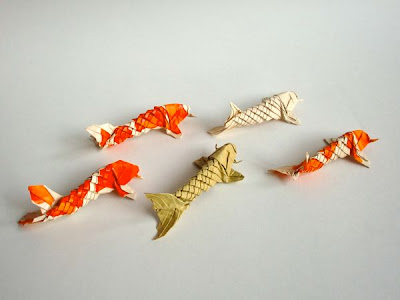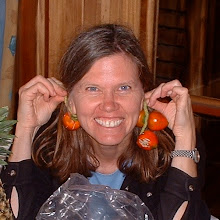My imaginary friends are very interesting people. That's what I call people I get to know on the internet such as other members of Ravelry or authors of interesting blogs. One of my favorite blogs about knitting is Asplund knits by a Swedish guy. Although we haven't met, we've exchanged enough comments and messages that I feel he is one of my realer imaginary friends.
In a recent post, he had photos of an fantastic sweater he is knitting. The thing I appreciate about Mr. Asplund's knitting is that even if he uses a pattern, he makes many interesting modifications to it. (I also like it that he doesn't have the entire thing planned out in advance, because it makes me feel more normal to know that other people do that too.) This particular sweater features a detail at the shoulder of black and white checks. Since then, he has also posted pictures of a very cunning facing for the sleeve cuff that is also checkerboard. I love little semi-hidden details like that. He also put his initials in the gusset under the arm.
His checkerboards got me thinking about how many cultures value checkerboard patterns. Mr. Rududu and I were in Peru four years ago and discovered that checkerboards have been very important there for centuries. There is a traditional religious offering cloth woven in Peru that consists of just 4 squares in natural alpaca colors. Here' an example I saw at El Centro de Textiles Traditionales del Cusco. Among the offerings are coca leaves, which don't give you a buzz but certainly do help with the discomfort of being at a very high altitude.
Amazingly, these warp-faced offering clothes traditionally have no cut edges; all four sides are selvedges. They do this by making a discontinuous warp. This mind-bogglingly difficult technique involves using two sets of warp threads that loop together in the middle. Then they fill in all of the warp by eventually inserting the weft with needles as the space gets smaller and smaller. This must take a very long time.
Aside from the somewhat magical aspect of weaving something with selvedges on all sides, Peruvian weavers don't like to waste their warp thread, which stands to reason since it's all hand spun and is a precious commodity. To clarify how they made these checkerboards, here is a photo of a weaver finishing up a piece by using every single bit of her warp.
You can see she has very little space left to separate the yarns (make a shed in weaver's parlance) and there is a needle laying on her weaving that she can use to feed the yarn through that space since it is now too tiny to use a shuttle. In the photo she is beating down the weft thread with a bone tool.
Finally, here is a somewhat more elaborate use of a checkerboard design in an old weaving displayed at the Archeological Museum in Lima. It makes me want to polish off my double-knitting techniques.
In a recent post, he had photos of an fantastic sweater he is knitting. The thing I appreciate about Mr. Asplund's knitting is that even if he uses a pattern, he makes many interesting modifications to it. (I also like it that he doesn't have the entire thing planned out in advance, because it makes me feel more normal to know that other people do that too.) This particular sweater features a detail at the shoulder of black and white checks. Since then, he has also posted pictures of a very cunning facing for the sleeve cuff that is also checkerboard. I love little semi-hidden details like that. He also put his initials in the gusset under the arm.
His checkerboards got me thinking about how many cultures value checkerboard patterns. Mr. Rududu and I were in Peru four years ago and discovered that checkerboards have been very important there for centuries. There is a traditional religious offering cloth woven in Peru that consists of just 4 squares in natural alpaca colors. Here' an example I saw at El Centro de Textiles Traditionales del Cusco. Among the offerings are coca leaves, which don't give you a buzz but certainly do help with the discomfort of being at a very high altitude.
Amazingly, these warp-faced offering clothes traditionally have no cut edges; all four sides are selvedges. They do this by making a discontinuous warp. This mind-bogglingly difficult technique involves using two sets of warp threads that loop together in the middle. Then they fill in all of the warp by eventually inserting the weft with needles as the space gets smaller and smaller. This must take a very long time.
Aside from the somewhat magical aspect of weaving something with selvedges on all sides, Peruvian weavers don't like to waste their warp thread, which stands to reason since it's all hand spun and is a precious commodity. To clarify how they made these checkerboards, here is a photo of a weaver finishing up a piece by using every single bit of her warp.
You can see she has very little space left to separate the yarns (make a shed in weaver's parlance) and there is a needle laying on her weaving that she can use to feed the yarn through that space since it is now too tiny to use a shuttle. In the photo she is beating down the weft thread with a bone tool.
Finally, here is a somewhat more elaborate use of a checkerboard design in an old weaving displayed at the Archeological Museum in Lima. It makes me want to polish off my double-knitting techniques.



























